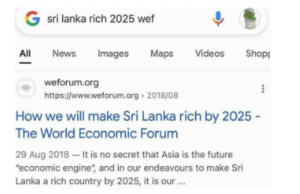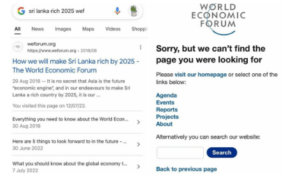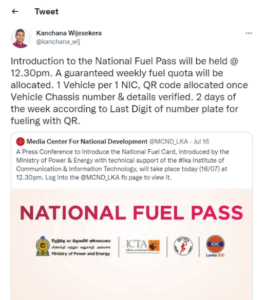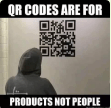Back on the 29th of August of 2018 the World Economic Forum published an article on its website entitled “How we will make Sri Lanka rich by 2025 – the World Economic Forum” stating that “It is no secret that Asia is the future ‘economic engine’ and they are endeavouring to make Sri Lanka a rich country by 2025…”

What happened to this article of theirs? It was deleted.

Why? Because as I pointed out in previous blogs the economy in Sri Lanka has collapsed.
Considering that as cabinet spokesperson Bandula Gunewardena said Sri Lanka had “never faced such a severe economic crisis in its history” it is very clear that the World Economic Forum is about everything except the economy and its flourishing. Or better still we can say that it is truly a forum on how to destroy the economy and thus it should change its name to “World Destroy the Economy Forum”.
And then it has the guts to have a meeting at Davos and talk about how to bring forth solutions to the current economical crisis.
Due to this collapse Sri Lanka has suspended all sales of fuel for non-essential vehicles amid this economic crisis. For two weeks only buses trains and vehicles used for medical services and transporting food were allowed to fill up with fuel.[1]
Nathan Piper the head of oil and gas research at Investec said that Sri Lanka is the first country to take the drastic step in halting sales of fuel to ordinary people “since the 1970s oil crisis when fuel was rationed in the US and Europe and speed limits introduced to reduce demand.”
In this light urban schools were closed and officials advised the country’s 22 million residents to work from home. But this could not be the case for taxi drivers who had to wait in queues for three days or more in order to get fuel.
What should raise eyebrows is that this move brought forth the implementation of the QR-code system-based fuel distribution a policy introduced and announced by the Power and Energy Minister of the country Kanchana Wijesekera at the behest of Sri Lanka’s new President Ranil Wickremesinghe — who happened to be a member and agenda contributorof the same World Economic Forum.[2]
In order to ease the long queues of people to get fuel Wijesekera wrote on Tweeter that thanks to this National Fuel Pass there is a guaranteed allocated fuel quota with one vehicle per one NIC and that this QR code will be allocated once the vehicle’s chassis number and details are verified.

“As per the Fuel Quota policies Sri Lankans will have to apply with their National Identity Card Numbers once their ID and other details are verified and will then be assigned a QR code to access gas at pumps across the country. Sri Lankans will then be made to take turns to get fuel based on the last digit of their vehicle registration numbers. However tourists and foreigners will be given priority to get fuel in Colombo (the largest city in Sri Lanka) — likely to avoid even more damage to Sri Lanka’s tourism industry.”[3]
As usual the problem-reaction-solution game in this case is as follows: the problem is the economical collapse; the reaction is the lack of fuel and the solution is enslaving Sri Lankans to buy fuel via the digital QR-code. Obviously they don’t tell you this. Instead Sri Lankans were told that if they do this they will not only get their dictated portion of fuel but that they will together save tourism.
[1]https://www.bbc.com/news/business-61961821
[2]https://www.business-standard.com/article/international/sri-lanka-to-implement-qr-code-system-based-fuel-distribution-from-today-122080100077_1.html
[3]https://thecountersignal.com/sri-lanka-implements-qr-code-digital-id-fuel-rationing/

